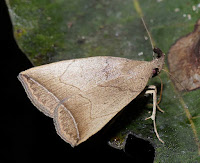Amazing world in one tree.
Erechthias citrinopa ERECHTHIINAE TINEIDAE
In our yard we have a grafted Brachychiton tree and around that tree in the early morning sun are swarms of tiny moths. All that can be seen are bright flashes as the sun catches the wings. They are very active and it is difficult to focus on them. Having captured one, it was so small (about 4 to 5mm), that I couldn't to get a good look at it. Imagine my delight when I saw what I had photographed.
 Family:- TINEIDAE
Family:- TINEIDAESub Family:- ERECHTHIINAE
Genus:- Erechthias
Species:- citrinopa
There is not much information on the biology of these moths.
I don't know what these moths use the tree for. If they are able to eat they may be after the sticky stuff on the leaves or the tree may be the larval food plant.
Last night I went spotlighting at the tree, and was not surprised to find a number of other moths species spiders, ants and of course the moths that I originally photographed.
Family:- GEOMETRIDAE
Sub Family:- LARENTIINAE
Genus:-
Species:-
Also see last weeks entry.
Family:- PYRALIDAE
Sub Family:- PHYCITINAE
Genus:-
Species:-

Family:- ARCTIIDAE
Sub Family:- LITHOSIINAE
Genus:- Scaptesyle
Species:- dichotoma
Family:- HERMINIIDAE
Sub Family:-
Genus:- Simplicia
Species:- armatalis
Note that all these moths are licking the surface of the leaves. They will either be drinking the honeydew or getting minerals. This licking is also common in many butterflies.
The tree is infested with leaf hoppers, possibly Flatid Planthoppers (Flatidae), in all stages of development and the sticky substance they excrete covers the leaves. The leafhoppers appear to be preyed upon by 3 species of ladybug. I also photographed a wasp that appears to harvest the sticky droplets from the leaf hopper nymphs by prodding them. There are numerous hover flies that hang around the tree later in the day. Many other insects can also be seen on the tree including other wasps, flies and lacewings.
What an amazing world there is in that one tree.























